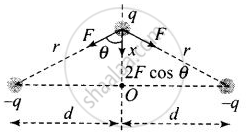Advertisements
Advertisements
प्रश्न
Two charges –q each are fixed separated by distance 2d. A third charge q of mass m placed at the mid-point is displaced slightly by x(x << d) perpendicular to the line joining the two fixed charged as shown in figure. Show that q will perform simple harmonic oscillation of time period.
`T = [(8pi^3 ε_0 md^3)/q^2]^(1/2)`

उत्तर

Let the charge q is displaced slightly by x(x << d) perpendicular to the line joining the two fixed charges. Net force on the charge q will be towards O. The motion of charge q to be simple harmonic, if the force on charge q must be proportional to its distance from the centre O and is directed towards O.
Net force on the charge Fnet = 2F cos θ
Here F = `1/(4piε_0) (q(q))/r^2 = 1/(4piε_0) q^2/((d^2 + x^2))`
And cos θ = `x/sqrt(x^2 + d^2)`
Hence, Fnet = `2[1/(4piε_0) q^2/((d^2 + x^2))][x/sqrt(x^2 + d^2)]`
= `1/(2piε_0) (q^2x)/(d^2 + x^2)^(3/2)`
= `1/(2piε_0) (q^2x)/(d^3 (1 + x^2/d^2)^(3/2)`
As x << d, then Fnet = `1/(2piε_0) (q^2x)/d^3` or Fnet = Kx
i.e., force on charge q is proportional to its displacement from the centre O and it is directed towards O. Hence, motion of charge q would be simple harmonic, where ω = `sqrt(K/m)`
And T = `(2pi)/ω = 2pi sqrt(m/K)`
⇒ T = `2pi sqrt((m * 4piε_0 d^3)/(2q^2)) = [(8pi^3ε_0 md^3)/q^2]^(1/2)`
APPEARS IN
संबंधित प्रश्न
An electric dipole of length 4 cm, when placed with its axis making an angle of 60° with a uniform electric field, experiences a torque of `4sqrt3`Nm. Calculate the potential energy of the dipole, if it has charge ±8 nC
(i)Obtain the expression for the torque `vecτ` experienced by an electric dipole of dipole moment `vecP` in a uniform electric field, `vecE` .
(ii) What will happen if the field were not uniform?
Define dipole moment of an electric dipole. Is it a scalar or a vector?
Two particles, carrying charges −q and +q and and of mass m each, are fixed at the ends of a light rod of length a to form a dipole. The rod is clamped at an end and is placed in a uniform electric field E with the axis of the dipole along the electric field. The rod is slightly tilted and then released. Neglecting gravity, find the time period of small oscillations.
The electric field at a point on the equatorial plane at a distance r from the centre of a dipole having dipole moment `vec "p"` is given by, (r >> separation of two charges forming the dipole, `epsilon_0 - ` permittivity of free space) ____________.
A conic surface is placed in a uniform electric field E as shown in the figure such that the field is perpendicular to the surface on the side AB. The base of the cone is of radius R, and the height of the cone is h. The angle of the cone is θ.

Find the magnitude of the flux that enters the cone's curved surface from the left side. Do not count the outgoing flux (θ < 45°)
An electric dipole of moment p is placed parallel to the uniform electric field. The amount of work done in rotating the dipole by 90° is ____________.
The ratio of the weight of a man in a stationary lift and in a lift accelerating downwards with a uniform acceleration α is 3 : 2. The acceleration of the lift is:
Show that intensity of electric field at a point in broadside position of an electric dipole is given by:
E = `(1/(4piepsilon_0)) "p"/(("r"^2 + l^2)^(3//2))`
Where the terms have their usual meaning.
